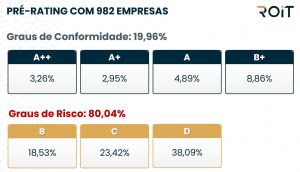The changes brought by the tax reform require Brazilian companies to adapt to a new fiscal scenario. To measure the corporate sector’s level of preparedness, ROIT, a company specialized in technology and artificial intelligence for tax management, developed and is introducing to the market the Tax Reform Rating. The initial results raise a red flag: 85% of organizations were classified as high-risk, indicating they are unprepared for the reform’s requirements. The analysis involved anonymous data and information from nearly 1,000 companies.
The tax reform was regulated last January. It will come into effect in 2026, gradually. By 2033, all changes should be implemented. Until then, companies must be ready not only to operate under new rules but, most importantly, to navigate this transition period. After all, for the next eight years, the old and new models will coexist.
Thus, amid this tangle of regulations, technology becomes indispensable for companies to assess their compliance. Aiming to provide a clearer overview of the challenges and opportunities brought by the reform, the index calculated by the Tax Reform Rating can become a strategic indicator for financial planning and decision-making in the private sector—essential, therefore, for executives in CEO, CFO, or Head of TAX roles, emphasizes tax expert Lucas Ribeiro, CEO of ROIT.

“The Tax Reform Rating has the potential to become a KPI (Key Performance Indicator), with relevance similar to other indicators like valuation (company value), NPS (customer satisfaction and loyalty level), or EBITDA (organization results). Thus, the methodology establishes a strategic benchmark,” evaluates Ribeiro.
The index is based on four main groups of factors: Strategic, Operational, Technological, and Human. Using data from the Public Digital Bookkeeping System (Sped), tax documents, and tax scenario simulations, the system cross-references information in real time and applies artificial intelligence to identify bottlenecks, opportunities, and risks for each company, supplemented by a thorough review of processes and systems.
In the end, companies receive a score and a categorization. According to ROIT’s CEO, they are as follows:
A++: Fully prepared for the reform, with hyper-automated processes, validated calculations, and complete strategic alignment.
A+: Strong compliance with the reform’s requirements, with pending adjustments in processes and technology.
A: Robust preparation but still vulnerable to specific issues, such as lack of integrated systems and manual processes.
B+: Intermediate capacity, with moderate operational risks and the need for adjustments in financial and tax control.
According to Lucas Ribeiro, in an environment of such profound changes as those brought by the tax reform, lack of preparedness can be fatal. Unprepared companies risk increased costs, loss of competitiveness, and even fines. “The Tax Reform Rating is a strategic guide. It shows where the company stands and provides clarity on the necessary steps to achieve compliance and even gain competitive advantages,” he reaffirms.
The expert explains that among the main advantages is the fact that the rating provides predictability, helping companies anticipate the reform’s impacts and avoid financial surprises; aids in strategic decision-making, offering data-driven insights for contract renegotiation, pricing, and tax management; and ensures market differentiation: companies with high ratings demonstrate maturity and responsibility, which can be a competitive edge.
“What we are delivering with the Rating is the possibility for companies to move from spectators to protagonists of the Tax Reform. Those who master the data make the rules,” emphasizes Ribeiro.
How to join the Tax Reform Rating?
The methodology is already available in an initial and free version, with a ‘Self-Assessment’ composed of over 35 questions covering the four key factors of the Rating.
At this stage, it is already possible to identify a company’s risk levels regarding the new tax rules. The analysis is detailed, with practical and customized recommendations to improve performance in the index.
After this step, companies can proceed with contracting and access the first reports within days. For Lucas, ‘the clock is ticking, and 2025 will be the decisive year. Those who start now will be ahead of market assumptions dictated by suppliers, clients, and, of course, competitors.’


